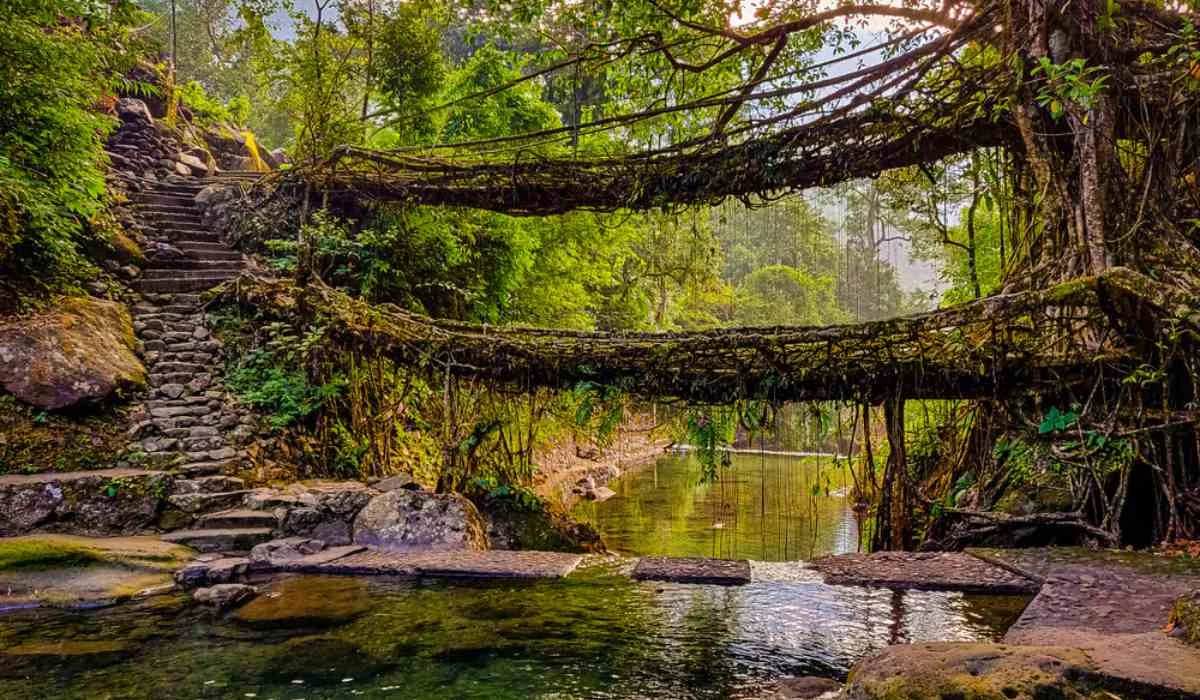Living root bridges are unique natural wonders found in the northeastern Indian state of Meghalaya, particularly in the Cherrapunji and Mawlynnong regions. These bridges are formed by guiding the aerial roots of rubber trees (Ficus elastica) across rivers and streams until they merge on the other side, creating sturdy and living pathways. Here’s what you need to know about these fascinating structures:
Formation: The living root bridges are created by the Khasi and Jaintia tribes of Meghalaya. They guide the roots of the rubber trees to grow across riverbanks, using bamboo scaffolding to shape the roots as they grow. Over the years, the roots strengthen and interweave, forming a living bridge that can support the weight of people.
Types of Living Root Bridges:
- Single-Deck Root Bridges: These are simple root bridges with one layer of intertwined roots. They are relatively shorter and are used to cross smaller streams.
- Double-Deck Root Bridges: These bridges have two layers of intertwined roots, creating a more robust structure. They are used to cross larger rivers and are considered more stable.
Advantages: Living root bridges are known for their durability. Unlike wooden or metal bridges that can decay or corrode, these living bridges become stronger over time as the roots continue to grow and mature.
Maintenance: The local communities regularly maintain the root bridges, ensuring that they remain strong and functional. They replace decaying or damaged bamboo scaffolding as needed.
Accessibility: Accessing some of the root bridges may require trekking through dense forests and challenging terrain. The journey itself is an adventure, allowing you to experience Meghalaya’s natural beauty.
Popular Living Root Bridges:
- Umshiang Double-Decker Root Bridge: Located in the village of Nongriat near Cherrapunji, this bridge is one of the most famous and impressive root bridges.
- Ritymmen Single-Decker Root Bridge: Another bridge near Nongriat, it’s a shorter trek from the village.
- Mawsaw Root Bridge: Located near the village of Mawsaw, it’s known for its unique structure and beautiful surroundings.
Trekking and Exploration: Trekking to these root bridges is a popular activity for adventure enthusiasts and nature lovers. It’s an opportunity to witness the traditional engineering skills of the Khasi people and immerse yourself in the region’s natural beauty.
Photography: The unique beauty of living root bridges, surrounded by lush greenery and flowing water, offers incredible photo opportunities.
Cultural Significance: These bridges are a testament to the harmony between humans and nature, reflecting the indigenous people’s sustainable practices.
Note: While planning your visit, consider the trekking difficulty and the current weather conditions. The rainy season might make the trails slippery. Also, respect local customs and guidelines when visiting these bridges.
Exploring the living root bridges in Meghalaya is not only an architectural marvel but also a chance to connect with nature and witness the ingenuity of local communities. As always, stay updated on the current situation and follow travel advisories for a safe and enjoyable experience

